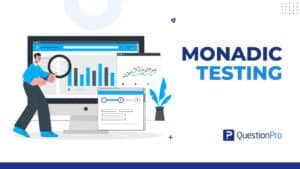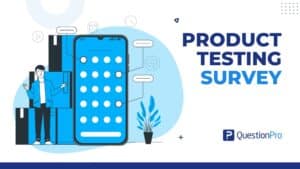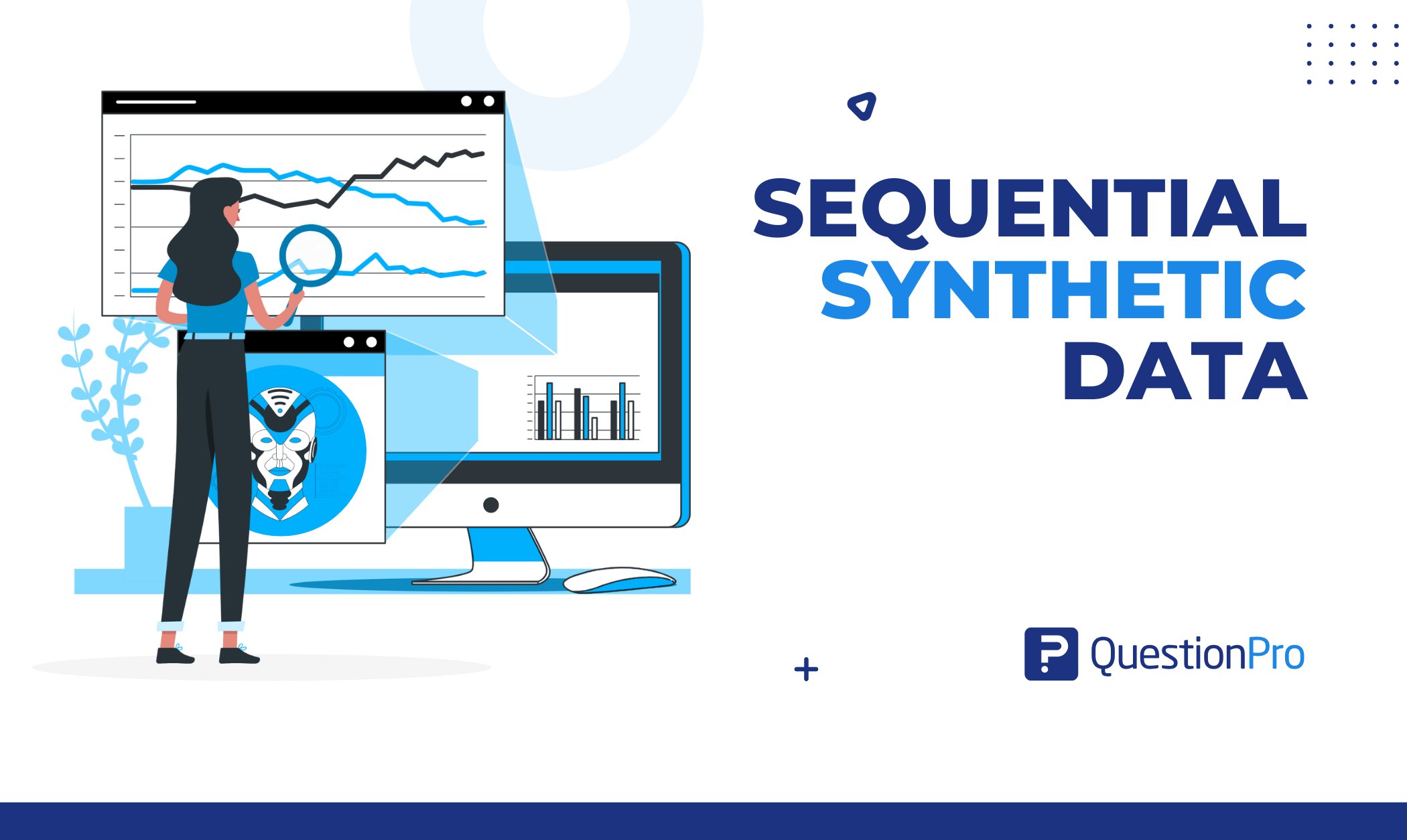
Surveys often give us a snapshot of a single moment of feedback. But real human behavior doesn’t happen in snapshots; it happens in sequences, a series of decisions, actions, and changes over time.
Unlike regular synthetic data, which generates isolated responses, sequential synthetic data simulates behavior as it unfolds over time. It’s like having a digital twin of your customer base, showing you how people might interact with your product, change their preferences, or respond to follow-up surveys in the future.
For platforms like QuestionPro, this technology opens up powerful new use cases: testing longitudinal surveys, simulating panel attrition, and predicting customer behavior without risking real respondent data.
In this blog, we’ll explain what sequential synthetic data is, how it works, and why it’s a game-changer for survey design, data analysis, and predictive research.
What is Sequential Synthetic Data?
Sequential synthetic data refers to artificially generated data that mimics real-world sequences, preserving the order, timing, and dependencies between events over time. Unlike flat, one-time data points, this type of data captures how things evolve, such as how a customer’s feedback changes after multiple interactions, or how employee satisfaction shifts over a quarter.
In the context of survey research, sequential synthetic data allows you to simulate how a respondent might behave or answer across multiple survey waves, phases in a panel study, or touchpoints in a customer journey.
It’s generated using AI techniques (like LSTMs, Transformers, or GANs) trained on real sequential datasets, then used to replicate those patterns without compromising privacy.
How Does Sequential Synthetic Data Differ from Regular Synthetic Data?
| Feature | Regular Synthetic Data | Sequential Synthetic Data |
| Structure | Flat, single-instance | Time-dependent, ordered |
| Use Case | One-time survey simulations | Longitudinal studies, behavioral predictions |
| Examples | Simulating one customer feedback form | Simulating a customer journey over 6 months |
| Modeling Needs | Simple distribution matching | Temporal modeling and dependencies |
Regular synthetic data replicates snapshots, such as one-time survey responses. Sequential synthetic data replicates stories of how things change and why.
Why Sequential Data Matters in Research?
In research, especially when using surveys or behavioral data, understanding change over time is critical. While a single response offers a snapshot, sequential data reveals the journey behind the response, and that’s where real insight lies.
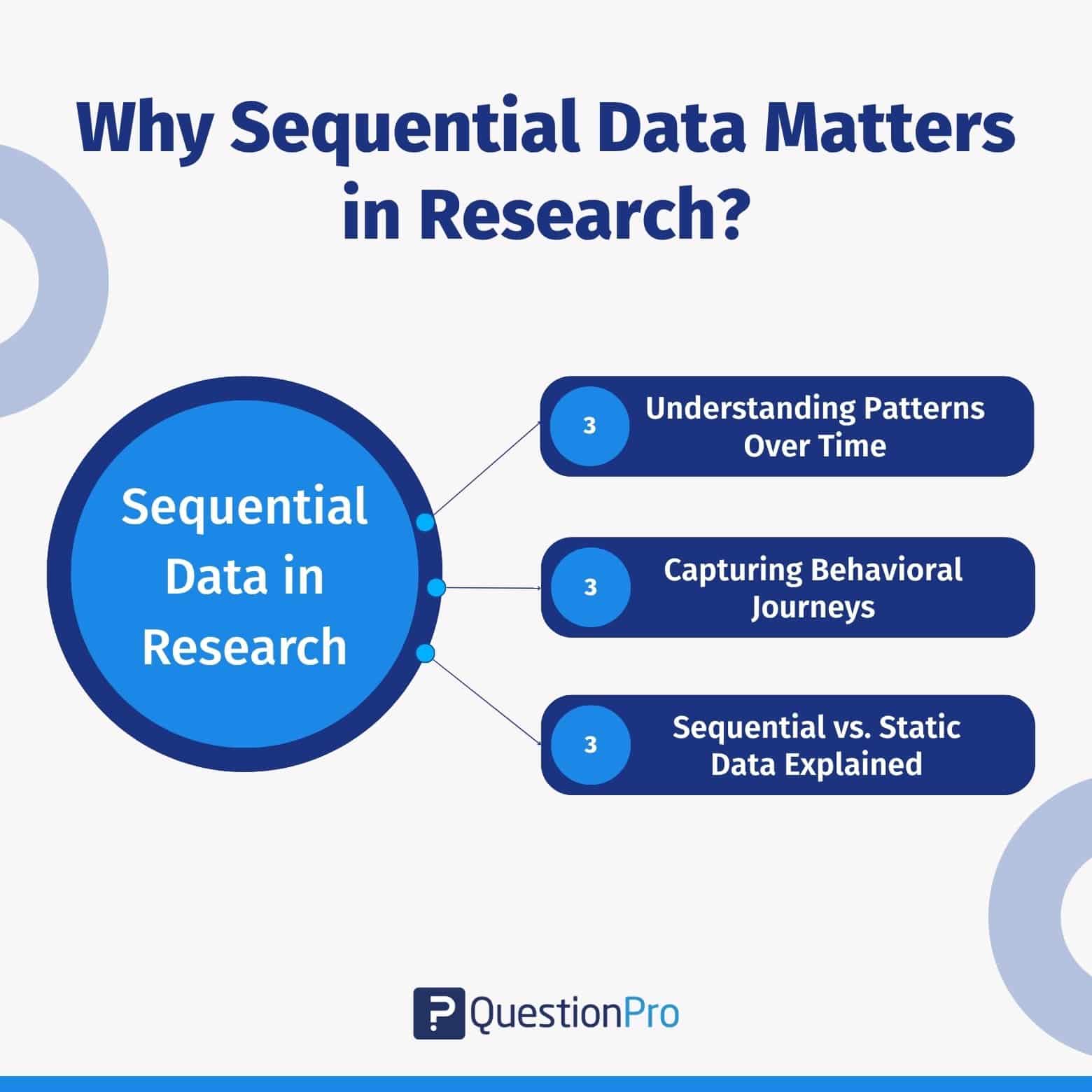
1. Understanding Patterns Over Time
Sequential data helps researchers see how things evolve. For example, instead of just knowing a customer gave a satisfaction score of 7, we can track how their scores changed over months, dropping after a support issue and rising again after a resolution. These patterns help identify triggers, trends, and moments of change.
2. Capturing Behavioral Journeys, Not Just Snapshots
Traditional research often captures data at one point in time, like a photo. But sequential data is more like a video; it shows the full journey. Whether it’s how an employee’s engagement shifts over a year or how a patient’s symptoms respond to treatment, sequential data gives the context behind each answer.
3. Sequential vs. Static Data Explained
Static data gives you a single snapshot (like a one-time survey result).
Sequential data captures a timeline of responses (like multiple survey rounds over a campaign).
By using sequential data, researchers can move beyond isolated answers and uncover the full context of behavior. Whether you’re tracking satisfaction across multiple surveys or mapping touchpoints in a customer journey, the value lies in the timeline, not just the moment.
Real-Life Examples of Sequential Data
Sequential data helps you understand how things change over time. Here are some real-world examples where this kind of data is useful in surveys and research:
- Customer Feedback Journeys: Track how a customer’s opinion changes from their first onboarding experience, through a support interaction, all the way to a renewal or exit survey.
- Employee Engagement Surveys: Measure how employees feel during key points in their journey, starting from onboarding, through performance reviews or promotions, and eventually at exit interviews.
- Product Experience Feedback: Gather feedback at different stages of product use. For example, right after setup, after one week of use, and after a feature update.
- Behavioral Tracking Studies: Use survey triggers to collect feedback before, during, and after a specific event, like an ad campaign, a product launch, or a website redesign.
These examples show how time-based data can reveal deeper patterns and help researchers make better decisions. And when privacy or data access is a concern, synthetic versions of these sequences can provide similar insights without the risks.
How Sequential Synthetic Data Works?
By using AI and machine learning, researchers can create synthetic sequences that look and behave like real ones, without revealing any personal or sensitive data.
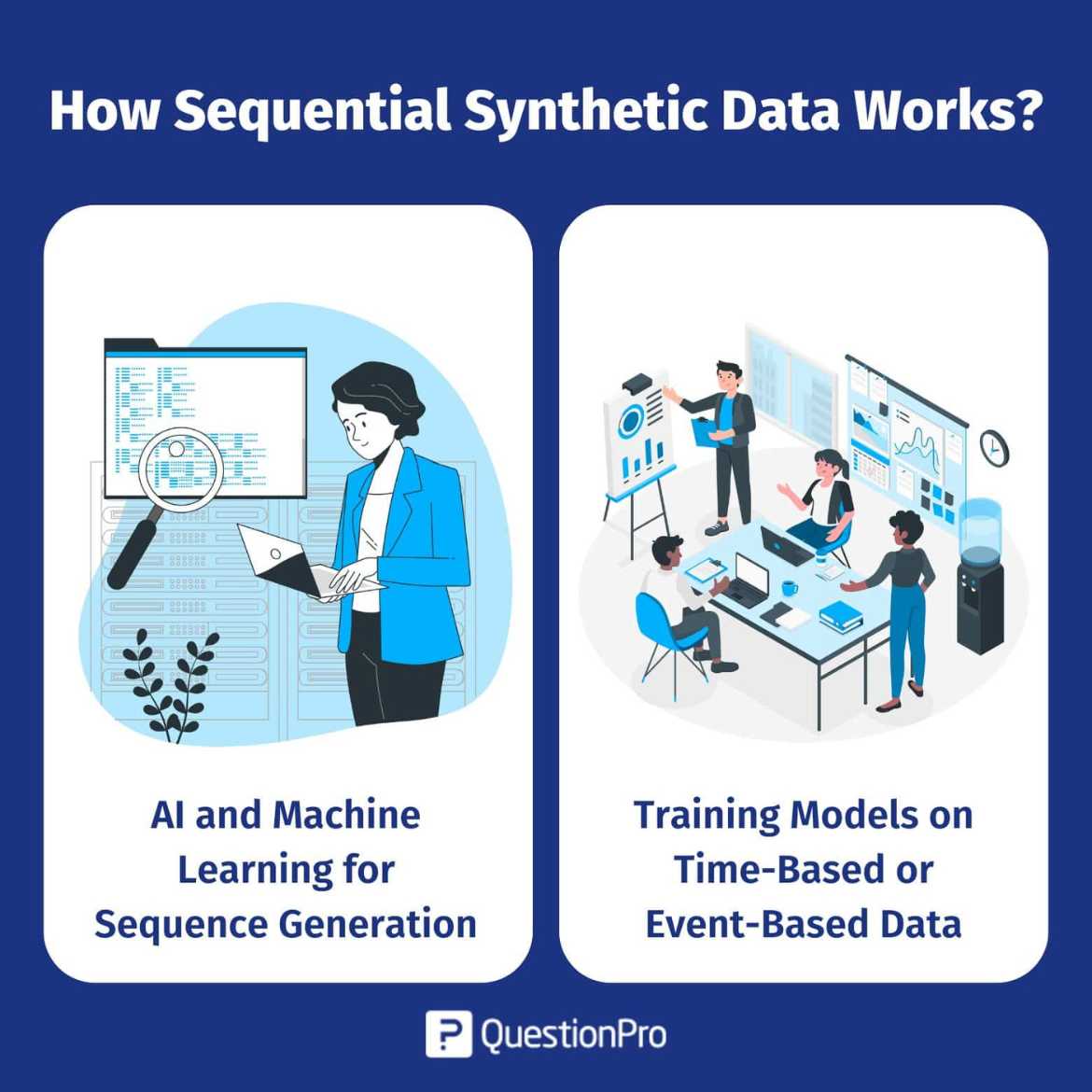
1. AI and Machine Learning for Sequence Generation
Techniques like Recurrent Neural Networks (RNNs), Long Short-Term Memory networks (LSTMs), and Transformers are designed to handle data that comes in sequences.
These models learn the patterns and dependencies in real-world time-series or event-driven data and can then generate new, realistic sequences based on that learning.
2. Training Models on Time-Based or Event-Based Data
To create accurate synthetic sequences, models need to be trained on time-stamped datasets or event logs.
For example, in QuestionPro, you might export longitudinal survey data or customer feedback collected over multiple touchpoints. These synthetic datasets can be used to train models that simulate how responses or behaviors might change in similar future scenarios.
Examples in Action
- Customer Journeys: Simulate how a customer might move from onboarding to loyalty or churn over time.
- Survey Response Patterns: Model how respondents engage or drop off during a long survey sequence.
- Churn Simulations: Predict the sequence of signals (like declining satisfaction) that might indicate someone is about to stop using a service.
By training on real temporal patterns and applying the right models, researchers can generate synthetic sequential data that is both useful and privacy-safe. These simulations can help test hypotheses, improve predictive models, and power smarter survey strategies without needing access to large volumes of real, sensitive data.
Applications of Sequential Synthetic Data in Survey Research
Sequential synthetic data isn’t just a theoretical concept; it has real, practical value in survey research. Whether you’re testing a new survey flow or trying to understand long-term behavior, synthetic sequences can fill in the gaps where real data is too limited, sensitive, or slow to collect.
1. Simulating Respondent Behavior Over Time
Instead of waiting for months of real panel data, you can generate synthetic sequences that mimic how respondents might behave across multiple survey rounds. For example, simulate how satisfaction scores might evolve across three quarterly surveys, or how awareness builds over a multi-touch campaign.
2. Modeling Survey Drop-Off and Engagement Patterns
Understanding where people disengage is key to improving survey completion rates. Synthetic sequences let you explore these patterns before launching.
Use cases include:
- Pinpointing high drop-off questions or fatigue triggers.
- Simulating how different question types or lengths affect respondent flow.
- Testing variations of survey logic or order without risking real participant data.
3. Predicting Customer Lifecycle Actions from Survey Data
By simulating how different segments respond over time, you can build predictive models that forecast key lifecycle moments, such as when a customer is likely to upgrade, churn, or need support. These patterns, once trained on historical survey data, can be replicated and tested using synthetic sequences.
With platforms like QuestionPro, researchers can collect, structure, and export time-based survey data, making it easy to power these applications with AI.
Whether you’re testing retention strategies, improving question flow, or building predictive analytics, sequential synthetic data adds speed, flexibility, and privacy to your research process.
Benefits of Synthetic Sequential Data
Sequential synthetic data offers a smart alternative. It gives you the structure and flow of actual behavior, minus the legal headaches or logistical delays. Here’s why that matters:
1. Safe, Privacy-Friendly Data for Testing and Modeling
Since the data is artificially generated, there’s no risk of exposing real respondent identities. This makes it ideal for testing workflows, sharing datasets, or simulating sensitive scenarios like patient health surveys or internal employee feedback without worrying about legal or ethical risks.
2. Stress-Testing Survey Logic Before Real Deployment
Launching a survey without knowing how people will interact with it? That’s a risk. Synthetic data gives you a safe testing ground. With sequential synthetic data, you can:
- Simulate respondent paths through different skip logic, branching, or time-based triggers.
- Catch friction points, dead ends, or illogical flows before fielding.
- Test long surveys for fatigue or abandonment risks without burning through your panel.
3. Enhance Predictive Models with Time-Based Simulations
Training a model with real-time data? That could take months.
Training it with synthetic sequences? That takes minutes.
- Create thousands of plausible respondent journeys instantly.
- Add time-awareness to your churn models, sentiment tracking, or experience scores.
- Fill data gaps without guessing.
This isn’t fake data. It’s smart, strategic modeling fuel.
4. Filling Data Gaps in Longitudinal Research
Longitudinal studies often suffer from incomplete data, missed responses, panel attrition, or long delays. Sequential synthetic data can help fill in those gaps by generating realistic continuation sequences based on available data.
Sequential synthetic data doesn’t just replicate reality; it helps you experiment, improve, and innovate faster. When combined with QuestionPro’s survey and analytics platform, you get a powerful toolkit for building better research strategies, backed by safe, scalable, and realistic data.
How QuestionPro Can Leverage Sequential Synthetic Data
As a full-fledged survey and research platform, QuestionPro Research Suite is the only one that can unlock the power of sequential synthetic data. From improving survey logic to building smarter predictive models, synthetic sequences can speed up and improve your research without compromising data privacy or waiting months for longitudinal insights.
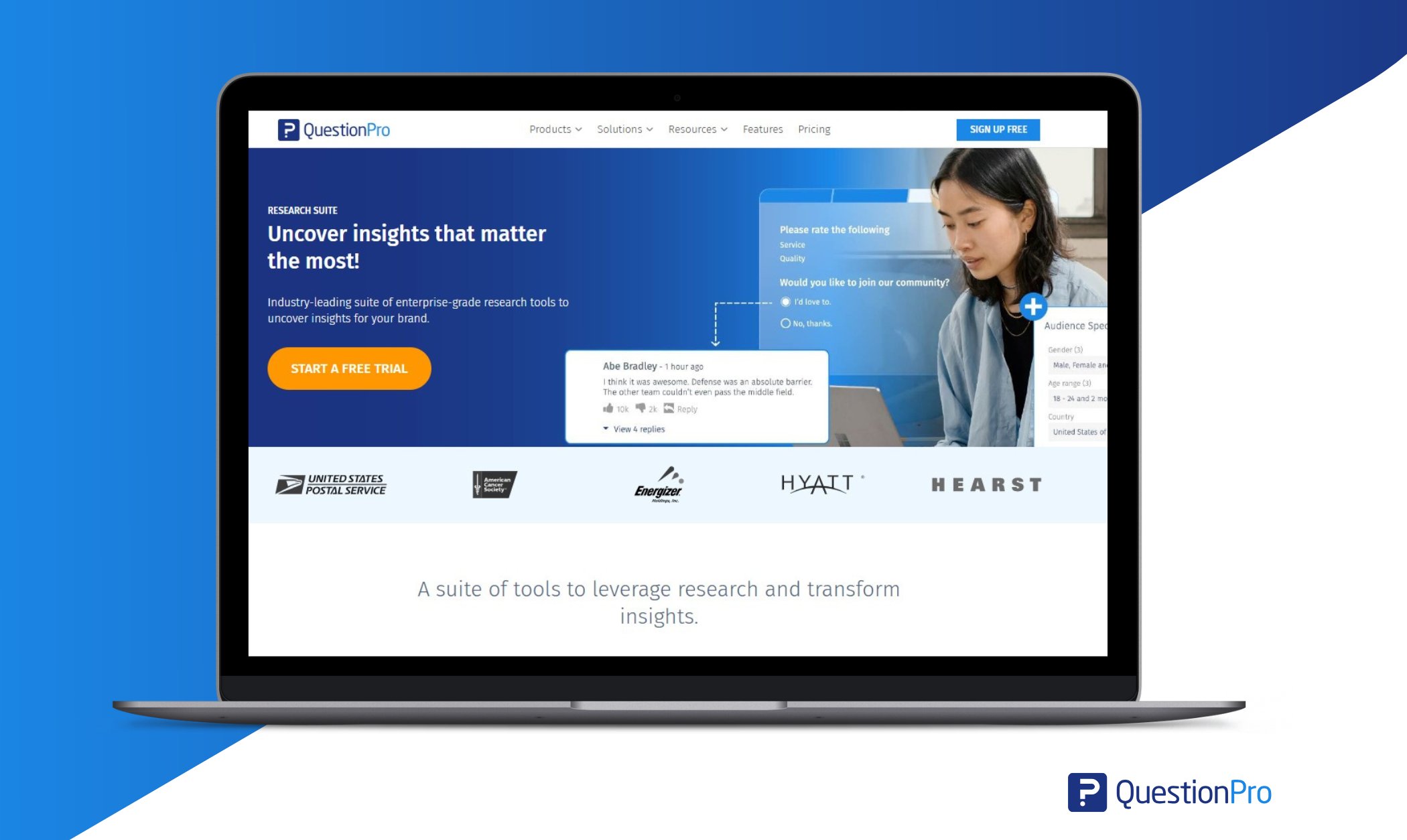
1. Testing Longitudinal Surveys and Panel Retention Strategies
With QuestionPro’s panel management and longitudinal survey capabilities, you can design multi-wave studies and track response patterns over time.
Sequential synthetic data lets you simulate those journeys in advance so you can test retention strategies, forecast drop-off rates, and optimize survey frequency before you deploy to your actual panel.
2. Improving Survey Experience Through AI-Driven Scenario Simulations
By generating synthetic response paths, you can simulate different types of participant behavior, such as what happens when a user rushes through the survey, skips certain questions, or drops out midway. These AI-driven scenarios let you test and refine skip logic, survey flow, and timing all within the QuestionPro platform.
3. Synthetic Behavioral Data for Training Analytics Models
QuestionPro’s analytics dashboards and predictive tools thrive on structured input. By using sequential synthetic data, you can train internal models like,
- Churn predictors.
- NPS trend monitors.
- Segmentation tools.
This gets your analytics up and running early, safely, and at scale.
4. Validating Survey Designs Without Real Respondents
Before you launch a survey, especially a complex one with multiple branching paths, you can use synthetic data to simulate how different audience segments might respond. This makes it easier to debug logic, catch inconsistent flows, and validate question order, all without burning budget or exhausting your panel.
5. Enhancing Survey Personalization with Simulated Behavior Patterns
Sequential synthetic data lets you see how different respondent types behave throughout the survey. For example:
- First-time users.
- Returning customers.
- Disengaged participants.
You can simulate how each group moves through the survey, where they engage, skip, or drop off. These patterns will tell you what content works best for different audiences.
From scenario testing to advanced analytics, QuestionPro can integrate sequential synthetic data into every stage of the research workflow.
Whether you’re running large panels, building predictive dashboards, or exploring new survey designs, synthetic sequences give you a safe, scalable way to experiment, learn, and improve before you go live.
Considerations of Sequential Synthetic Data
While sequential synthetic data offers exciting possibilities, it also comes with responsibility. Researchers and organizations must be mindful of how they generate, use, and interpret synthetic sequences, especially when using them to make decisions that affect real people.
1. Transparency in Synthetic Data Usage
It’s important to disclose when synthetic data is used, especially:
- Research reports.
- Training models.
- shared datasets.
Transparency builds trust with stakeholders and helps avoid confusion between real and generated insights.
2. Avoiding Misuse or Over-Reliance on Simulated Outcomes
Synthetic data is a powerful simulation tool, but it’s still a simulation. It should never replace real-world validation. Decisions based solely on synthetic sequences risk missing edge cases or unexpected real-world behavior.
3. Ensuring Fairness and Bias Control in Generated Sequences
If the training data contains bias, the synthetic data will likely carry it forward or even amplify it. Researchers should audit both input and output datasets to ensure underrepresented groups or behaviors are not overlooked or misrepresented.
Using sequential synthetic data ethically means treating it as a supplement, not a substitute, for real-world insights. When combined with strong validation, clear communication, and awareness of bias, it becomes a safe and responsible tool for modern research.
Conclusion
Sequential synthetic data is a powerful way to simulate time-based behaviors, test survey logic, and train predictive models without using sensitive or hard-to-collect real-world data.
This type of synthetic data allows you to capture the entire journey, not just a snapshot, while keeping privacy, flexibility, and scalability across studies. Through this article, you can get a better idea of sequential synthetic data.
If you are already using QuestionPro, you are already ahead of the curve in using sequential synthetic data. Export your longitudinal or panel survey data, identify behavioral patterns, and use external AI tools to generate synthetic sequences.
FAQs(Frequently Asked Question)
Answer: It helps researchers move beyond static snapshots to understand behavioral journeys. With sequential data, you can track how opinions shift, identify drop-off points, and capture patterns that unfold over weeks, months, or even years.
Answer: Not entirely. It’s best used as a supplement. While it allows for safe simulation, testing, and modeling, real-world validation is still essential to confirm accuracy and avoid over-reliance on artificial outcomes.
Answer: Yes. You can simulate how respondents with different behaviors, like first-time users or disengaged participants, would navigate your survey. This lets you identify friction points and logic issues before using your real panel.
Answer: Yes. Researchers must be transparent when synthetic data is used, avoid making decisions solely based on simulations, and ensure that biases in training data don’t carry over into the generated sequences.
Answer: Start by exporting longitudinal or panel-based survey data from your QuestionPro account. Analyze patterns, use external AI tools to generate synthetic sequences, and apply those simulations to test, model, or refine your research strategies.




